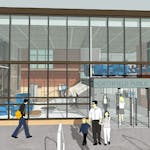The era of hypergrowth on the outer fringes of the Twin Cities' suburbs may be over.
Scott County, once one of the nation's 10 fastest-growing, has slipped to 166th. Growth in Chisago County, once firmly established among the top 100, is in free-fall and now ranks 683rd. A metro area that routinely placed several of its counties among the top 100, no longer has any, according to numbers released today by the U.S. Census Bureau.
"In a chilly northern state, you need a hot economy to grow fast, and the economy is not hot," demographer Hazel Reinhardt said about the steep descent in the national rankings of suburban counties.
The slowdown has consequences. People in city halls who have been processing thousands of building permits are losing their jobs. Cities such as Woodbury and Cottage Grove are reassigning staffers from approving developments and inspecting new homes to keeping an eye on those abandoned in mid-construction -- watching for graffiti or burst pipes.
In Woodbury, the developers of the high-profile Dancing Waters and Stonemill Farms projects throttled back this year, with lots remaining empty until the market comes back.
"We're certainly seeing some [slowdown] now with the smaller builders," said Dwight Picha, the city's community development director. "During the years of high growth, small builders were building a lot of spec homes, but that quit a year to 18 months ago."
The city itself is being more cautious, he added. The city's comprehensive plan, now being updated, won't open a new area for development until 2010. "We're not investing in any future infrastructure that we might not use."
Across from Shakopee High School, in the county seat of Scott County, new homes stand isolated amid fields of grass, looking more like farmhouses than the suburbs. Named streets lead to other named streets -- on which no one lives.
Hector Reborlorio, a Guatemalan immigrant idle from his job landscaping homes, is free on a weekday to work with a pair of friends on the basement of his newly purchased home. Where most of his neighbors' homes should be, there is mud and tall grass. Down the street, teenagers from the high school use the empty streets as free parking to dodge the school district's annual $60 fee.
"It's very quiet out here," says the father of two.
If the prominence that comes from making the Top 100 list is to vanish, though, said Minnesota's state demographer, Tom Gillaspy, it's more symbolic than a sign of any collapse.
"Scott County so far this decade has averaged 4.8 percent annual growth. But last year's 3.1 percent is still pretty fast. Sherburne's average of 4.1 is down to 2.4; but again, that's pretty rapid growth.
"What's really happening here is that the 'torrid '90s' are over, and we are settling back to where we were in the '70s, which was not particularly bad."
The new population estimates cover changes between 2006 and mid-2007. There are signs that housing construction has slowed even more since then -- not only here but in lots of other places.
"A number of suburban counties nationwide will see a lot slower growth," Gillaspy said.
Even as that happens, though, he said, parts of outstate Minnesota are doing better. Counties like Olmsted, centered on the city of Rochester, and Douglas, in the northern lakes country, are outgrowing some suburban counties.
"Much of non-Twin Cities Minnesota is doing well by historic standards," Gillaspy said. "If you're growing corn or wheat right now, you're probably doing pretty well."
And, of course, the newest of the suburban subdivisions border on farmland -- land that county assessors in Dakota and Scott agree is rising in value even as the value of many homes and lots is falling.
Amid the newly developing subdivisions circling Shakopee High School on Wednesday, Julie Donnay, a member of the family that runs Donnay Homes, was supervising the cleanout of furniture from a model home -- "a home we've sold, thank goodness!" -- and its shipment to another model home in another subdivision, across town.
Surely a new high school across the street is an attractive thing to buyers?
"It is, but people can't sell the homes they have -- or won't admit they have to drop the price to do that. People really need to get a grip, and realize they can sell more cheaply because they can also buy more cheaply.
"My husband and I are actually building a home for ourselves, and we're finding that everything's more reasonable in price, right down to all the subs. We need fewer discouraging headlines and more reminders that it's a great time to buy."
David Peterson • dapeterson@startribune.com • 952-882-9023 Lora Pabst • lpabst@startribune.com • 612-673-4628




